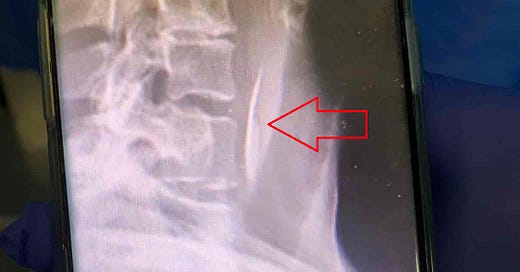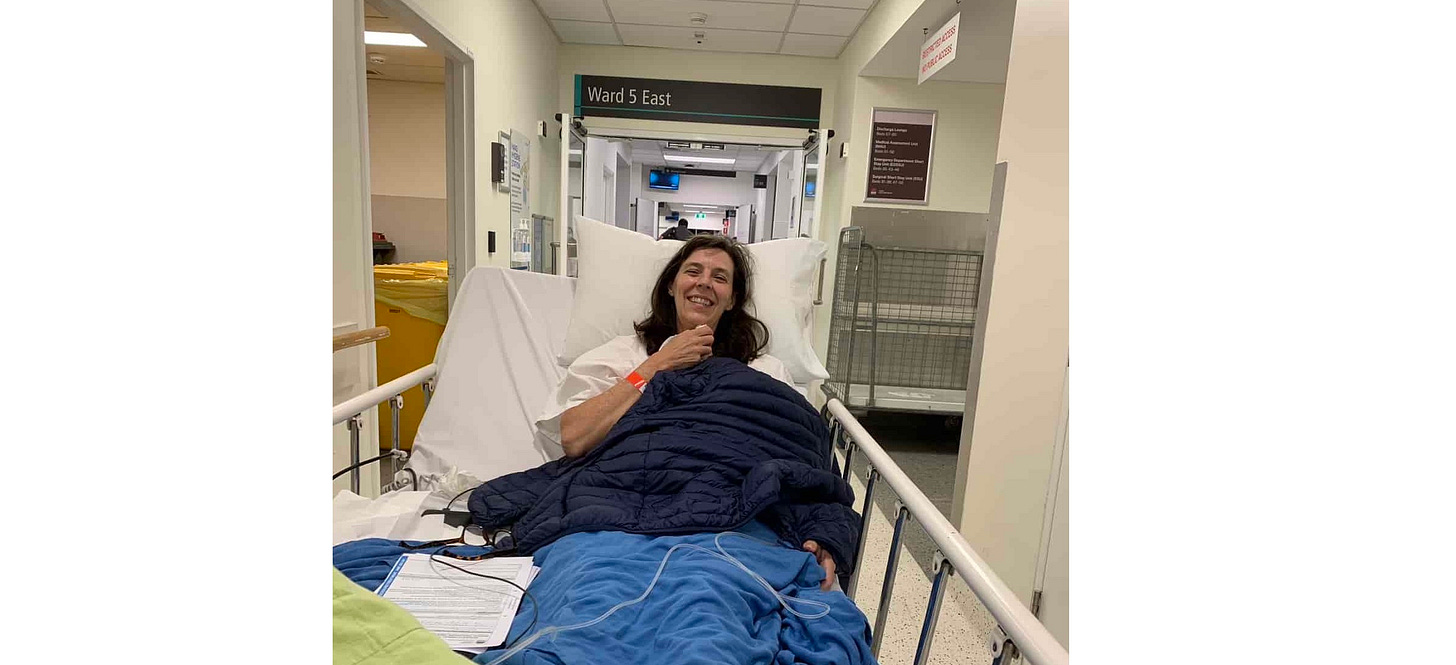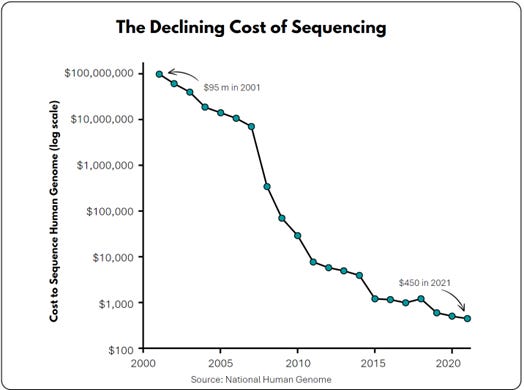152 | I Swallowed a Big Sharp Thing! | WGS Solves a Listeria Outbreak |
Spaghetti marinara meal leads to emergency surgery
Three things I’ve learned in 3 years of The Rotten Apple;
What it feels like to be injured by food ;
WGS: the game-changing tech for solving mystery outbreaks;
Food Safety News and Resources;
Learn about food smuggling;
Food fraud news, emerging issues and recent incidents.
Hi everyone!
Welcome to Issue 152 of The Rotten Apple, where I get way too close to my subject matter and explain exactly how it feels to be the victim of a physical contamination event.
Also this week, we explore how whole genome sequencing has changed food safety investigations radically - and for the better! - and learn about the motivations of food smugglers. Plus, I celebrate three years and 458,000 words with this newsletter.
Cheers,
Karen
P.S. Thank you for being part of our global network of food safety champions. Know someone who would love this? Please tell them about it.
Lessons learned from 3 years of food safety writing
The Rotten Apple turns three
For those who don’t know me, I launched this newsletter after leaving my job as senior technical manager at a boutique food safety certification business to spend more time on my food fraud prevention business, which I had founded in 2015.
I was spending a lot of time reading food industry news and saw an unmet need for food safety coverage that was thoughtfully curated, something different from your usual feed of Salmonella recalls. There was a need for articles that were deep but not too academic, that would keep readers up to date with emerging issues and let them dive into topics they hadn’t found the time to research for themselves without having to wade through advertisements and thinly disguised brand promotions.
I took a gamble that there would be a growing audience looking for carefully curated content that was truly global and presented with expert insights by someone with real food science knowledge and genuine food industry experience, instead of journalists and academics.
You all prove me right every week. Thank you so much for being here.
To celebrate this milestone, here are three things I’ve learned along the way:
Readers value personal connections. I started writing food safety content almost two decades ago, but this publication is the first time I have done it as a person, not a faceless company. It’s a unique and joyful way to share analysis, insights and opinions. There is something very personal about sending an email directly to each of you every Monday, and I value the space you make for me in your busy schedules.
Curation is valuable. If you’ve been reading for a while you’ll know that I rarely create original content like an investigative journalist would. Instead, I collect, curate and digest information from trusted sources. I see myself as a kind of digital magpie, seeking the most interesting morsels of knowledge from around the interwebs and presenting them to you in a way that is easy to read and saves you time.
Paying for media is essential. There’s a reason more and more news and entertainment sources are erecting paywalls every day. It’s expensive to produce good content, and digital advertising doesn’t always provide enough revenue for even the big media outlets to succeed without membership fees. While much of The Rotten Apple is free to read, paid subscriptions are what make this publication possible. Without my wonderful paying subscribers, I couldn’t do what I do for you every week. If you’ve been on the fence about paying, know that most subscribers are expensing this newsletter, either directly with their employer or through work-related tax deductions. Monthly subscriptions are just US$10 with no minimum commitment. Please consider subscribing today.
If you’ve been here from the beginning, thank you, I hope you continue to enjoy the reading as much as I enjoy the writing. If you’re new here, welcome, thank you for joining us as we explore the wonderful world of food safety, food fraud and sustainable supply chains. Here’s to the next three years!
How it Feels to Get a Food-Related Injury
In Issue 150 I described the experience of a man who endured a painful E. coli infection as part of the 2024 UK supermarket sandwich outbreak.
Stories about real consumers and their experiences are a powerful tool for food safety training - they help trainees understand the ‘why’ of food safety and can be remembered months after the rest of the training material has been forgotten. Today’s story also has a human face - mine.
Last week I swallowed something large and sharp while chomping into a plate of freshly cooked spaghetti marinara at a suburban restaurant. I noticed the object at the back of my mouth just as I commenced to swallow, a millisecond too late to ABORT ABORT ABORT!!!
As the object disappeared down my gullet, my internal alarm bells started wailing. This was no ordinary fish-scale- or appleseed-swallowing experience. This was excruciating and scary. I checked my breathing: can breathe, airway not blocked (good) and sprinted for the bathroom to attempt damage control.
In the restaurant’s tiny bathroom, I tried desperately to reach, dislodge and disgorge the thing that was now jammed in my throat. It felt very sharp, and I guessed it was a piece of mussel shell because the dish I had been eating had contained whole mussels on the shell. Returning to the table, I pawed through the remains of the meal, while my friends watched, wide-eyed. Yes, there was a mussel shell missing a large triangular piece.
I wrapped the broken mussel shell in a napkin and took it with me to the nearest hospital, where I waved it at the emergency department staff while pointing, panic-stricken, at my throat. “That,” I croaked, pointing at the missing part of the mussel shell, “is in here”.

If you’ve never attended the emergency department waving a broken mussel shell dripping tomato passata, I can’t say I recommend the experience. But their response was swift, and I soon had a tiny camera snaking down the back of my nose.
No sign of anything with the camera, the object was too deep. X-rays confirmed it was embedded just below the first sphincter of my oesophagus (who knew we have two sphincters between mouth and stomach?!).
To my horror, the hospital’s ear-nose-throat consultant said he couldn’t retrieve it from that location and called the surgeon who put me on the list for emergency surgery the following morning.
Surgery, with full general anaesthesia, was needed - an unwelcome surprise. But I wasn’t going to argue: anything - ANYTHING - to get that thing out of me, the sooner the better.

As someone who has solo-parented toddlers and endured two natural births, I can’t say the next few hours were the worst of my life. But they came close. I had to spend the night sitting upright to reduce the chance of damaging nerves in my neck, while fighting to avoid swallowing, which was excruciatingly painful, despite salivating like Niagara Falls.
Had the shell had punctured my oesophagus? We wouldn’t know until the surgeon got in to survey the damage. If there was a puncture I would need to stay in hospital with a feeding tube until it healed, for maybe a week, they said. Gulp.
It was a huge relief when they took me for surgery the next morning. I woke up afterwards with an enormous specimen jar next to my bed. Inside was a triangular-shaped piece of mussel shell. Fortunately, the surgeon had been able to remove it without causing further damage. Plus, she hadn’t needed to cut into my neck to reach it, hooray. And the oesophagus wasn’t punctured either.
All in all, a great outcome and I’m none the worse for my adventure.
Corrective actions
The restaurant owner was mortified by the incident and the cook apologetic. My friend had examined the rest of my meal after I left (okay, he ate it!) and found more shards of shell in the spaghetti sauce. He told the owner what happened and kept him updated about my prognosis.
From a food safety perspective, it’s hard to categorise this incident. As a consumer, I’m upset I was injured (also embarrassed that I didn’t notice the object before I swallowed it!) But as a food safety professional, it’s difficult to argue massive negligence on the part of the cook.
Do you classify a piece of mussel shell as a foreign object in a dish containing whole mussels? Probably not. It’s more like getting a seed in a package of pitted dates. And although the piece of shell definitely counts as a physical hazard, food safety hazards being defined as something which could cause illness or injury, I’m not sure that its presence in the dish represents a systematic food safety failure.
The cook threw away the rest of the marinara mix and says he will check for broken shells on the whole mussels as he plates up in future. I will attempt to track down the marinara mix supplier, to let them know what happened.
Takeaways for food professionals
Food safety conversations usually focus on microbial hazards, with physical hazards receiving significantly less attention. When foreign objects are found in food we often talk more about the ‘yuck’ factor (hair in soup, baby rats in chickpeas), and less about the injuries they might cause.
Until last week, I wasn’t aware that surgery was needed if you got something stuck in your throat. I hope this story has broadened your knowledge too, and given you something interesting to talk about next time you discuss physical hazards with your food safety team or front-line workers.
And if you are eating a dish with mussels, don’t forget to chew!
WGS Solves a 10-year Outbreak
Earlier this year, food safety investigators made a startling announcement. They had solved a Listeria outbreak which had been going for ten years.
Ten years! The first illnesses were reported in the United States in 2014 and the most recent in December 2023. During that time, at least twenty three people, including two newborns, were hospitalised with listeriosis, one baby was lost to miscarriage and two people died. But until February 2024 no one knew exactly where the illnesses had originated.
In this post we’ll learn how an outbreak can last for ten years, and why it was suddenly able to be ‘solved’.
The secret to the investigation’s ultimate success lies with a relatively new technology called whole genome sequencing (WGS). WGS determines the detailed genetic identity of an organism, revealing the order and number of nucleotides—adenine (A), guanine (G), cytosine (C), and thymine (T)—in the organism’s DNA (deoxyribonucleic acid). This gives a complete and detailed picture of its genetic makeup, including gene structure, function, and variation.
WGS also allows investigators to discover links between patients whose illnesses are separated by distance and time. In food safety incident investigation it’s a game-changer. Rather than simply saying “Listeria made that patient sick”, epidemiologists can now determine how closely related the illness-causing strain is to Listeria samples isolated from other patients.
In food safety incident investigation, whole genome sequencing (WGS) is a game changer.
WGS also allows investigators to positively match samples from a factory environment, and food samples, to pathogens isolated from sick people. Using it to provide evidence of a genetic match between environmental samples, food samples and patients is like finding a smoking gun in a murder investigation.
WGS is not ‘new’ but was not used extensively in food investigations or surveillance until recently because it was prohibitively expensive. The cost of performing whole genome sequencing has plummeted in the past two decades thanks to advances in sequencing technology, going from millions of dollars to less than $1,000 per sample.
With the cost reduced, public health professionals can now use WGS data to understand the relatedness of strains of a pathogen and make links between microorganisms from different samples, which is crucial for tracking the sources and spread of foodborne outbreaks.
The ten-year outbreak was previously thought to be a collection of small and unconnected outbreaks, until WGS was performed on patient samples, which had been kept in storage, revealing the Listeria involved in each outbreak was genetically similar.
Three-quarters of the patients reported eating queso fresco, cotija or similar styles of white cheese and three people remembered eating Don Fransico-brand soft white cheese. In January 2024, food safety officials in Hawaii discovered Listeria in cheese during routine sampling. The Listeria was a genetic match to the organisms in the patients. The contaminated cheese came from the same factory that produces Don Fransico cheese.
Following this discovery, investigators went looking for evidence of Listeria at the factory, where they discovered a ‘smoking gun’. An organism with a genetic match to the bacteria in the patient samples was found in containers used to store the cheeses between production and packing.
More than 60 products and 13 brands of cheese from the factory were subsequently recalled because every product went through the contaminated containers.
“Every time a new product was going through those containers it was being contaminated” explained Associate Professor Darren Detwiler of Northeeastern University.
While it seems perhaps miraculous that more people were not sickened by the contaminated containers, that probably comes down to the nature of listeriosis. It is a foodborne illness that causes only mild symptoms, or no symptoms in healthy adults. Only vulnerable people, including the elderly, infants, foetuses, pregnant mothers and the immunocompromised experience severe effects from listeriosis.
In addition, for every person who is reported as having a foodborne illness (in the United States), there is an estimated 22 who are not reported by their doctors and dozens more who do not seek medical attention.
The ten-year outbreak is now officially over, solved by investigators using WGS and Pulsenet, the US system which stores and compares samples from foodborne, waterborne and zoonotic illnesses. Without those technologies, the source of this outbreak would not have been discovered, and the contaminated containers could still be in use, posing a risk to vulnerable consumers to this day.
Did you know? Listeria can take up to 70 days – more than two months – to cause symptoms.
Takeaways for food professionals
Contamination events from poor food handling practices, such as inadequate sanitising of work-in-progress (WIP) containers are now more likely to be traced back to the at-fault facility. With the ‘smoking gun’ of WGS there is no longer anywhere to hide for businesses that don’t prioritise food safety.
Sources
AP News. (2024). Deadly decadelong listeria outbreak linked to cotija and queso fresco from a California business. [online] Available at: https://apnews.com/article/listeria-outbreak-cojita-queso-fresco-cheese-35da4c83d3cf8ce024250ef70971a030.
CDC (2024). Investigation Update: Listeria Outbreak, Queso Fresco and Cotija Cheese - February 2024. [online] Listeria Infection (Listeriosis). Available at: https://www.cdc.gov/listeria/outbreaks/details-cheese-02-24.html [Accessed 19 Aug. 2024].
Hibbert, C.M. (505AD). Why it took a decade to find the source of a deadly listeria outbreak. [online] Northeastern Global News. Available at: https://news.northeastern.edu/2024/02/07/listeria-outbreak-cheese-dairy/.
🍏 More: Listeria and Biofilms (Issue 97) 🍏
Food Safety News and Resources
No algorithm, just dedication… our news and resources are a carefully handcrafted selection from around the globe, expertly curated😎 and free from filler, fluff and promotional junk.
Worst food safety news of the week: raw milk cheese producer refuses to recall or assist investigators after Listeria monocytogenes found in its products 😣
Click the preview below to access it.
Learn about food smuggling
From maple syrup to baby eels and fish maws, learn about some of the world’s most frequently smuggled foods and discover why they are moved clandestinely around the world, with some smugglers even saying they have legitimate reasons for doing so.
This video from Business Insider is 29 minutes long and talks about smuggling in the supply chains of six high-value food commodities.
Below for paying subscribers: Food fraud news, horizon scanning and incident reports
In this week’s food fraud news:
📌 Cargo seal vulnerabilities and best practices;
📌 Butter adulteration;
📌 Cargo theft warning for certain countries;
📌 Curry powder, mango juice, dynamite fish and more.






